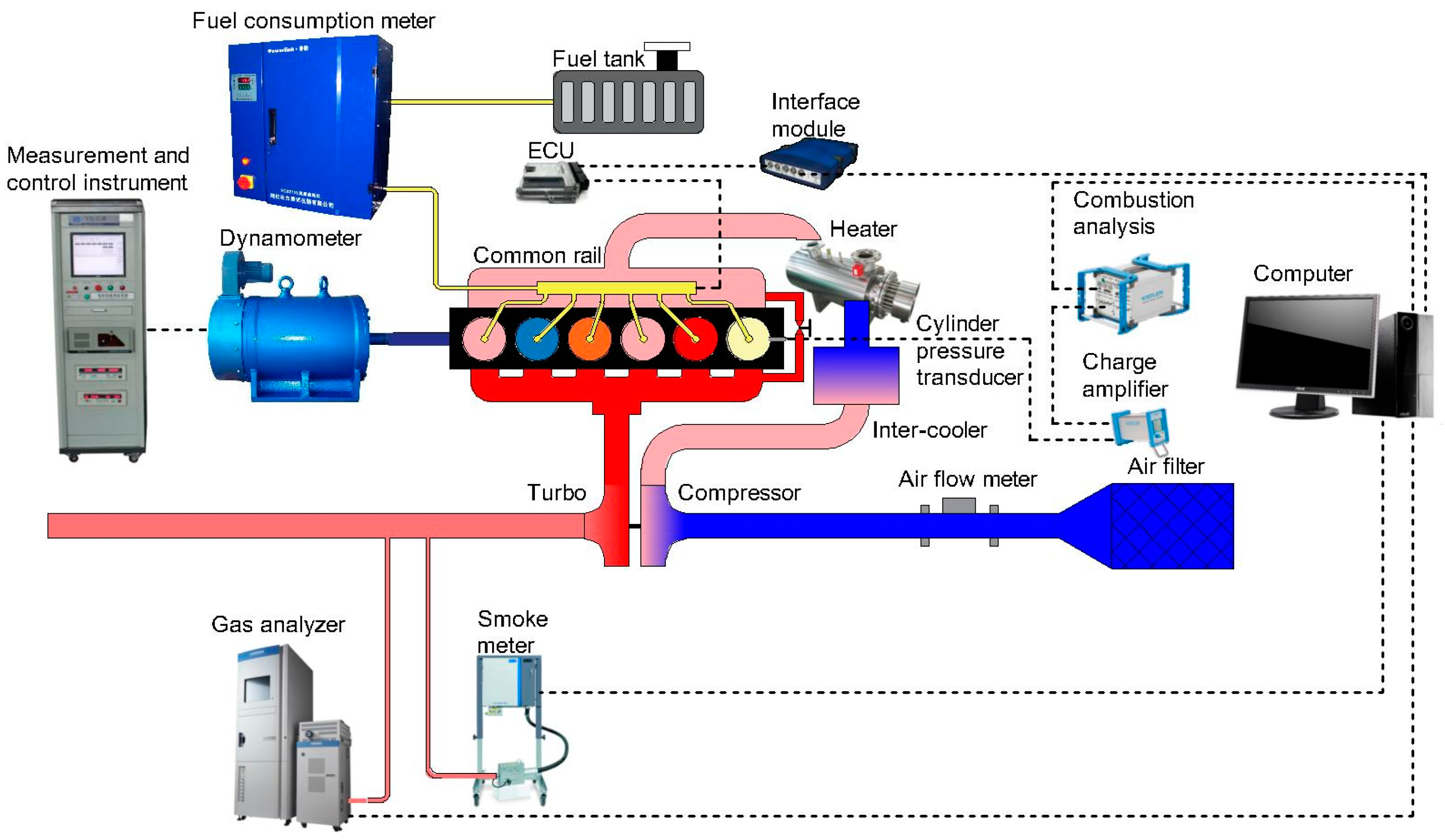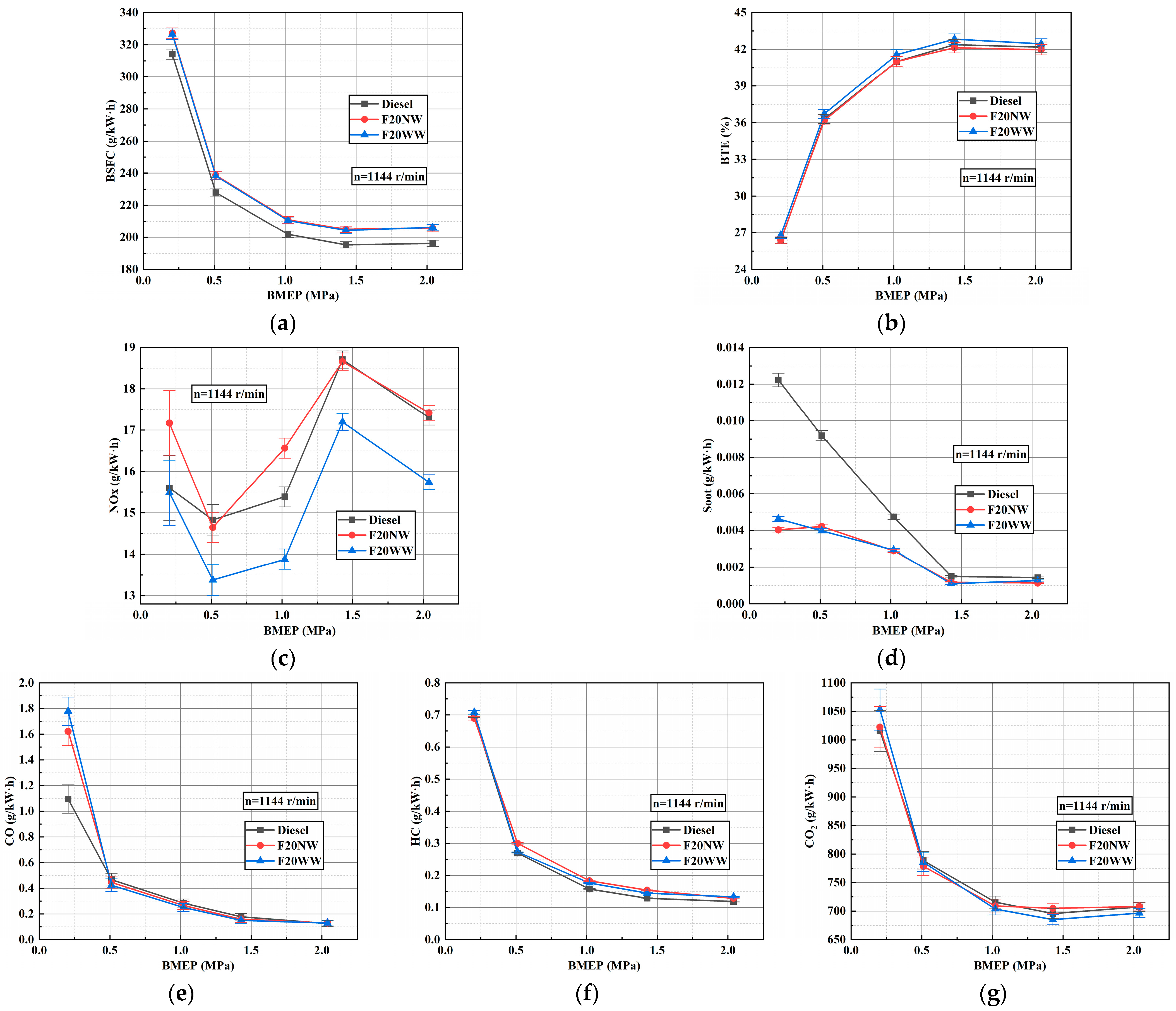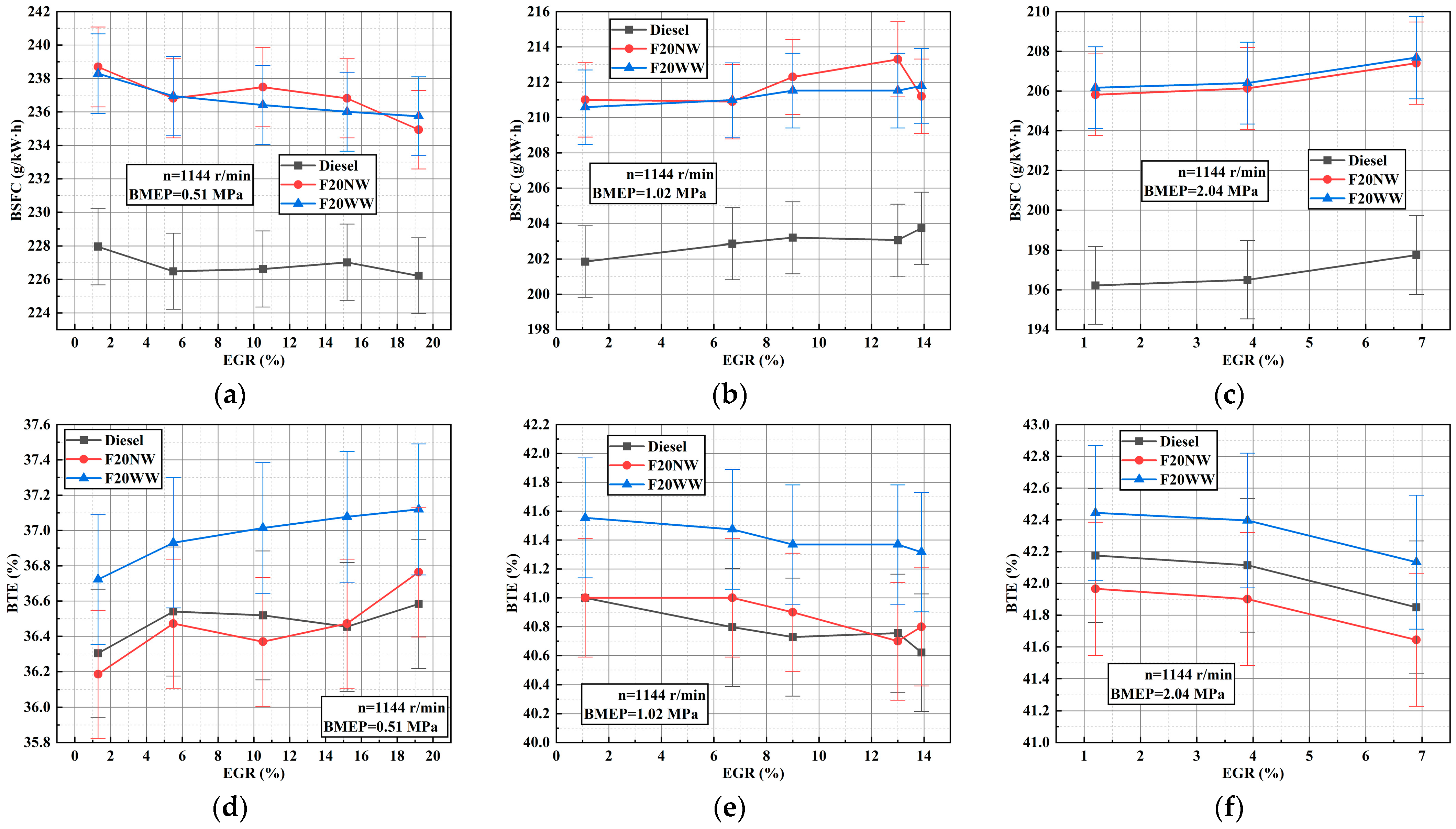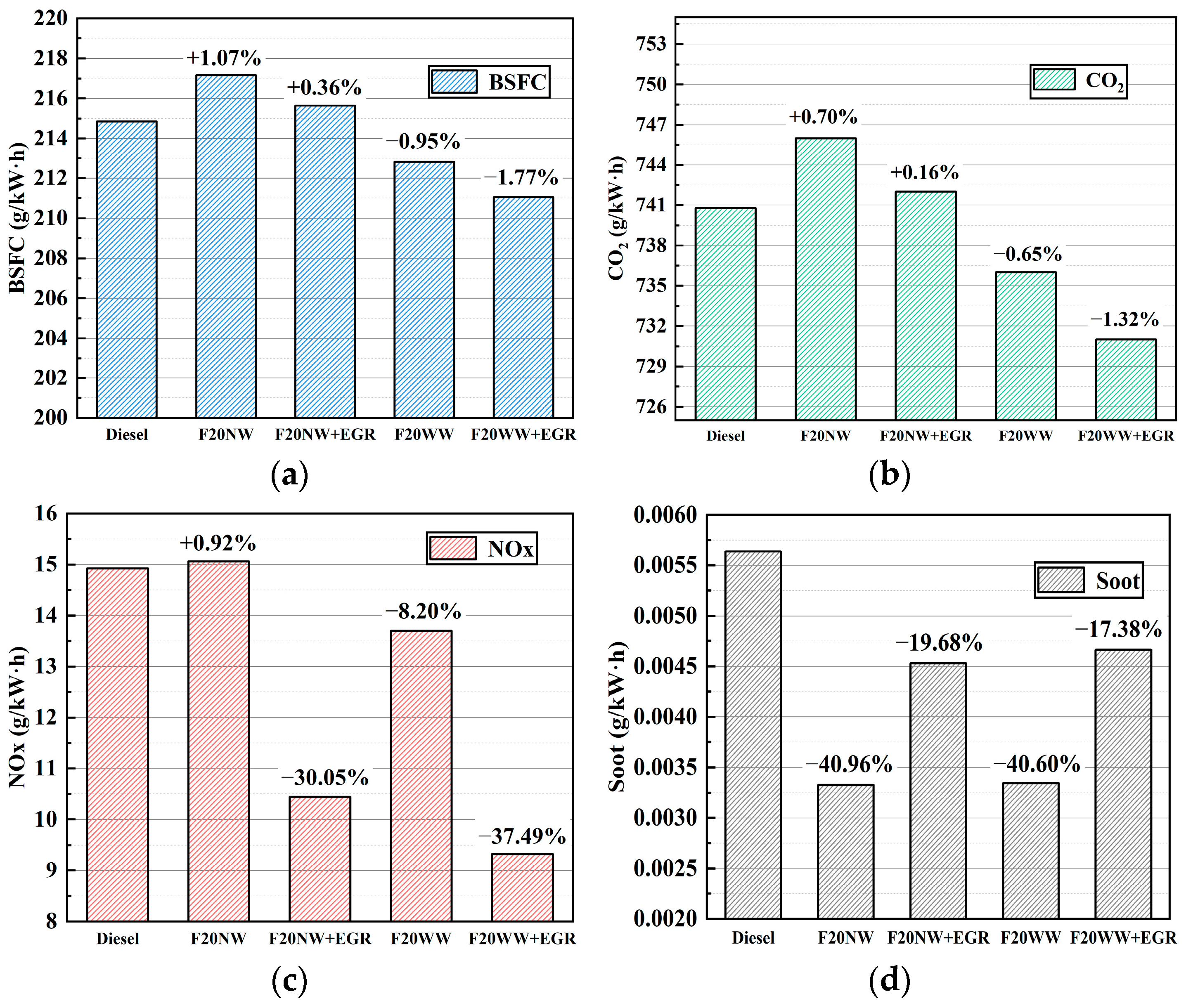Effects of Anhydrous and Hydrous Fusel Oil on Combustion and Emissions on a Heavy-Duty Compression-Ignition Engine
Abstract
:1. Introduction
2. Test Apparatus and Methods
2.1. Test Facility
2.2. Test Fuels
2.3. Test Conditions
3. Results and Discussions
3.1. Effect of Fusel Oil and the Existence of Water in Fusel Oil on Combustion
3.2. Effect of the Fusel Oil and the Existence of Water in Fusel Oil at Different BMEP
3.3. Effect of the EGR on Fuel Consumption and Emissions of Different Test Fuels at Different BMEP
3.4. Experiment of WHSC Test Cycle
4. Conclusions
- (1)
- The addition of fusel oil prolonged the ignition delay period, increased the peak value of heat release rates at low speed, and prolonged the combustion duration under high load.
- (2)
- Under different engine loads, the addition of hydrous fusel improved the break thermal efficiency and reduced NOx and soot emissions, and it could be further improved in combination with EGR optimization.
- (3)
- In terms of the WHSC test cycle, with the application of F20NW, the equivalent fuel consumption was increased by 0.36%. NOx and soot emissions were reduced by 30.05% and 19.08%, respectively, with the optimization of EGR compared with pure diesel. There was no significant difference in CO2 emissions between pure diesel and F20NW. And with the application of F20WW, the equivalent fuel consumption was reduced by 1.77%. NOx, soot, and CO2 emissions were reduced by 37.49%, 17.38%, and 1.32%, respectively, with the optimization of EGR compared with pure diesel.
Author Contributions
Funding
Data Availability Statement
Acknowledgments
Conflicts of Interest
References
- Hoseini, S.S.; Najafi, G.; Ghobadian, B.; Mamat, R.; Sidik, N.A.C.; Azmi, W.H. The effect of combustion management on diesel engine emissions fueled with biodiesel-diesel blends. Renew. Sustain. Energy Rev. 2017, 73, 307–331. [Google Scholar]
- Pereira, P.A.P.; de Andrade, J.B.; Miguel, A.H. Measurements of semivolatile and particulate polycyclic aromatic hydrocarbons in a bus station and an urban tunnel in Salvador, Brazil. J. Environ. Monit. 2020, 4, 558–561. [Google Scholar]
- Reitz, R.D. Directions in internal combustion engine research. Combust. Flame 2013, 160, 1–8. [Google Scholar]
- Huang, H.; Liu, Q.; Teng, W.; Wang, Q. The potentials for improving combustion performance and emissions in diesel engines by fueling n-butanol/diesel/PODE3-4 blends. Energy Procedia 2017, 105, 914–920. [Google Scholar]
- Huang, J.; Wang, Y.; Li, S.; Roskilly, A.P.; Yu, H.; Li, H. Experimental investigation on the performance and emissions of a diesel engine fuelled with ethanol–diesel blends. Appl. Therm. Eng. 2009, 29, 2484–2490. [Google Scholar]
- Hung, D.; Chen, H.; Xu, M.; Yang, J.; Zhuang, H. Experimental investigation of the variations of early flame development in a spark-ignition direct-injection optical engine. J. Eng. Gas Turbines Power 2014, 136, 101503. [Google Scholar]
- Laha, P.; Chakraborty, B. Energy model—A tool for preventing energy dysfunction. Renew. Sustain. Energy Rev. 2017, 73, 95–114. [Google Scholar]
- Li, Y.; Jia, M.; Liu, Y.; Xie, M. Numerical study on the combustion and emission characteristics of a methanol/diesel reactivity controlled compression ignition (RCCI) engine. Appl. Energy 2013, 106, 184–197. [Google Scholar]
- Li, Y.; Jia, M.; Chang, Y.; Liu, Y.; Xie, M.; Wang, T.; Zhou, L. Parametric study and optimization of a RCCI (reactivity controlled compression ignition) engine fueled with methanol and diesel. Energy 2014, 65, 319–332. [Google Scholar]
- Liu, H.; Zhang, X.; Zhang, Z.; Wu, Y.; Wang, C.; Chang, W.; Zheng, Z.; Yao, M. Effects of 2-ethylhexyl nitrate (EHN) on combustion and emissions on a compression ignition engine fueling high-pressure direct-injection pure methanol fuel. Fuel 2023, 341, 127684. [Google Scholar]
- Soudagar, M.E.M.; Nik-Ghazali, N.N.; Kalam, M.A.; Badruddin, I.A.; Banapurmath, N.R.; Akram, N. The effect of nano-additives in diesel-biodiesel fuel blends: A comprehensive review on stability, engine performance and emission characteristics. Energy Convers. Manag. 2018, 178, 146–177. [Google Scholar]
- İlhak, M.I.; Doğan, R.; Akansu, S.O.; Kahraman, N. Experimental study on an SI engine fueled by gasoline, ethanol and acetylene at partial loads. Fuel 2020, 261, 116148. [Google Scholar]
- Chen, Z.; Yang, F.; Xue, S.; Wu, Z.; Liu, J. Impact of higher n-butanol addition on combustion and performance of GDI engine in stoichiometric combustion. Energy Convers. Manag. 2015, 106, 385–392. [Google Scholar]
- Chen, Z.; Zhang, Y.; Wei, X.; Zhang, Q.; Wu, Z.; Liu, J. Thermodynamic process and performance of high n-butanol/gasoline blends fired in a GDI production engine running wide-open throttle (WOT). Energy Convers. Manag. 2017, 152, 57–64. [Google Scholar]
- Geng, P.; Yao, C.; Wang, S.; Zheng, L.; Zang, R.; Tang, C. Effects of Methanol-Gasoline Improved Fuel on the Performance of Gasoline Engine. J. Eng. Thermophys. 2013, 34, 183–188. [Google Scholar]
- Geng, P.; Yao, C.; Wei, L.; Liu, J.; Wang, Q.; Pan, W.; Wang, J. Reduction of PM emissions from a heavy-duty diesel engine with diesel/methanol dual fuel. Fuel 2014, 123, 1–11. [Google Scholar]
- Geng, P.; Zhang, H.; Yang, S.; Yao, C. Comparative study on measurements of formaldehyde emission of methanol/gasoline fueled SI engine. Fuel 2015, 148, 9–15. [Google Scholar]
- Rakopoulos, D.C.; Rakopoulos, C.D.; Giakoumis, E.G.; Papagiannakis, R.G. Evaluating oxygenated fuel’s influence on combustion and emissions in diesel engines using a two-zone combustion model. J. Energy Eng. 2018, 144, 04018046. [Google Scholar]
- Liu, H.; Li, S.; Zheng, Z.; Xu, J.; Yao, M. Effects of n-butanol, 2-butanol, and methyl octynoate addition to diesel fuel on combustion and emissions over a wide range of exhaust gas recirculation (EGR) rates. Appl. Energy 2013, 112, 246–256. [Google Scholar]
- Liu, H.; Ma, G.; Hu, B.; Zheng, Z.; Yao, M. Effects of port injection of hydrous ethanol on combustion and emission characteristics in dual-fuel reactivity controlled compression ignition (RCCI) mode. Energy 2018, 145, 592–602. [Google Scholar]
- Liu, H.; Wang, X.; Wu, Y.; Zhang, X.; Jin, C.; Zheng, Z. Effect of diesel/PODE/ethanol blends on combustion and emissions of a heavy duty diesel engine. Fuel 2019, 257, 116064. [Google Scholar] [CrossRef]
- Nanthagopal, K.; Kishna, R.S.; Atabani, A.; Al-Muhtaseb, A.H.; Kumar, G.; Ashok, B. A compressive review on the effects of alcohols and nanoparticles as an oxygenated enhancer in compression ignition engine. Energy Convers. Manag. 2020, 203, 112244. [Google Scholar]
- Nour, M.; Attia, A.M.A.; Nada, S.A. Combustion, performance and emission analysis of diesel engine fuelled by higher alcohols (butanol, octanol and heptanol)/diesel blends. Energy Convers. Manag. 2019, 185, 313–329. [Google Scholar] [CrossRef]
- Zheng, Z.; Yue, L.; Liu, H.; Zhu, Y.; Zhong, X.; Yao, M. Effect of two-stage injection on combustion and emissions under high EGR rate on a diesel engine by fueling blends of diesel/gasoline, diesel/n-butanol, diesel/gasoline/n-butanol and pure diesel. Energy Convers. Manag. 2015, 90, 1–11. [Google Scholar] [CrossRef]
- Zheng, Z.; Li, C.; Liu, H.; Zhang, Y.; Zhong, X.; Yao, M. Experimental study on diesel conventional and low temperature combustion by fueling four isomers of butanol. Fuel 2015, 141, 109–119. [Google Scholar] [CrossRef]
- Zhuang, H.; Hung, D.; Xu, M.; Chen, H.; Li, T.; Zhang, Y.; Yang, J.; Men, Y. Flame Area Correlations with Heat Release at Early Flame Development of Combustion Process in a Spark-Ignition Direct-Injection Engine Using Gasoline, Ethanol and Butanol; SAE Technical Paper 2013-01-2637; SAE International: Warrendale, PA, USA, 2013. [Google Scholar]
- Rakopoulos, C.D.; Antonopoulos, K.A.; Rakopoulos, D.C. Experimental heat release analysis and emissions of a HSDI diesel engine fueled with ethanol–diesel fuel blends. Energy 2007, 32, 1791–1808. [Google Scholar] [CrossRef]
- Rakopoulos, D.; Rakopoulos, C.; Kakaras, E.; Giakoumis, E. Effects of ethanol–diesel fuel blends on the performance and exhaust emissions of heavy duty DI diesel engine. Energy Convers. Manag. 2008, 49, 3155–3162. [Google Scholar] [CrossRef]
- Rakopoulos, C.D.; Rakopoulos, D.C.; Kosmadakis, G.M.; Papagiannakis, R.G. Experimental comparative assessment of butanol or ethanol diesel-fuel extenders impact on combustion features, cyclic irregularity, and regulated emissions balance in heavy-duty diesel engine. Energy 2019, 174, 1145–1157. [Google Scholar] [CrossRef]
- Wu, Y.; Zhang, X.; Zhang, Z.; Wang, X.; Geng, Z.; Jin, C.; Liu, H.; Yao, M. Effects of diesel-ethanol-THF blend fuel on the performance and exhaust emissions on a heavy-duty diesel engine. Fuel 2020, 271, 117633. [Google Scholar] [CrossRef]
- Xing, Y.; Yao, M.; Zhang, F.; Zheng, Z. Experimental investigation on combustion and emission characteristics of engine fuelled with ethanol-diesel blends. Trans. CSICE 2007, 25, 24–29. [Google Scholar]
- Awad, O.I.; Ali, O.M.; Mamat, R.; Abdullah, A.; Najafi, G.; Kamarulzaman, M.; Yusri, I.; Noor, M. Using fusel oil as a blend in gasoline to improve SI engine efficiencies: A comprehensive review. Renew. Sustain. Energy Rev. 2016, 69, 1232–1242. [Google Scholar] [CrossRef]
- Muthaiyan, P.; Gomathinayagam, S. Combustion Characteristics of a Diesel Engine Using Propanol Diesel Fuel Blends. J. Inst. Eng. 2016, 97, 1–7. [Google Scholar] [CrossRef]
- Pinzi, S.; Macías, R.; Leiva-Candia, D.; Soriano, J.; Dorado, M. Influence of ethanol/diesel fuel and propanol/diesel fuel blends over exhaust and noise emissions. Energy Procedia 2017, 142, 849–854. [Google Scholar] [CrossRef]
- Rakopoulos, D.; Rakopoulos, C.; Hountalas, D.; Kakaras, E.; Giakoumis, E.; Papagiannakis, R. Investigation of the performance and emissions of bus engine operating on butanol/diesel fuel blends. Fuel 2010, 89, 2781–2790. [Google Scholar] [CrossRef]
- Chen, Z.; Wu, Z.; Liu, J.; Lee, C. Combustion and emissions characteristics of high n-butanol/diesel ratio blend in a heavy-duty diesel engine and EGR impact. Energy Convers. Manag. 2014, 78, 787–795. [Google Scholar] [CrossRef]
- Yao, M.; Wang, H.; Zheng, Z.; Yue, Y. Experimental study of n-butanol additive and multi-injection on HD diesel engine performance and emissions. Fuel 2010, 89, 2191–2201. [Google Scholar] [CrossRef]
- Kumar, R.B.; Saravanan, S. Use of higher alcohol biofuels in diesel engines: A review. Renew. Sustain. Energy Rev. 2016, 60, 84–115. [Google Scholar] [CrossRef]
- Yılmaz, E. Investigation of the effects of diesel-fusel oil fuel blends on combustion, engine performance and exhaust emissions in a single cylinder compression ignition engine. Fuel 2019, 255, 115741. [Google Scholar] [CrossRef]
- Atmanli, A. Comparative analyses of diesel–waste oil biodiesel and propanol, n-butanol or 1-pentanol blends in a diesel engine. Fuel 2016, 176, 209–215. [Google Scholar] [CrossRef]
- Campos-Fernandez, J.; Arnal, J.M.; Gomez, J.; Lacalle, N.; Dorado, M.P. Performance tests of a diesel engine fueled with pentanol/diesel fuel blends. Fuel 2013, 107, 866–872. [Google Scholar] [CrossRef]
- Pour, A.H.; Ardebili, S.M.S.; Sheikhdavoodi, M.J. Multi-objective optimization of diesel engine performance and emissions fueled with diesel-biodiesel-fusel oil blends using response surface method. Environ. Sci. Pollut. Res. 2018, 25, 35429–35439. [Google Scholar] [CrossRef]
- Kryshtopa, S.; Kryshtopa, L.; Melnyk, V.; Dolishnii, B.; Prunko, I.; Demianchuk, Y. Experimental research on diesel engine working on a mixture of diesel fuel and fusel oils. Transp. Probl. 2017, 12, 53–63. [Google Scholar] [CrossRef]
- Akcay, M.; Ozer, S. Experimental investigation on performance and emission characteristics of a CI diesel engine fueled with fusel oil/diesel fuel blends. Energy Sources Part A Recovery Util. Environ. Eff. 2019, 1–16. [Google Scholar] [CrossRef]
- Awad, O.I.; Mamat, R.; Ali, O.M.; Yusri, I.M.; Abdullah, A.A.; Yusop, A.F.; Noor, M.M. The effect of adding fusel oil to diesel on the performance and the emissions characteristics in a single cylinder CI engine. J. Energy Inst. 2017, 90, 382–396. [Google Scholar] [CrossRef]
- Flowers, D.L.; Aceves, S.M.; Frias, J.M. Improving Ethanol Life Cycle Energy Efficiency by Direct Utilization of Wet Ethanol in HCCI Engines; SAE Technical Paper 2007-01-1867; SAE International: Warrendale, PA, USA, 2007. [Google Scholar]
- Shapouri, H.; Duffield, J.A.; Wang, M. The energy balance of corn ethanol revisited. Trans. ASAE 2003, 46, 959–968. [Google Scholar] [CrossRef]
- Fang, W.; Kittelson, D.B.; Northrop, W.F. Optimization of reactivity-controlled compression ignition combustion fueled with diesel and hydrous ethanol using response surface methodology. Fuel 2015, 160, 446–457. [Google Scholar] [CrossRef]
- Fang, W.; Fang, J.; Kittelson, D.B.; Northrop, W.F. An experimental investigation of reactivity-controlled compression ignition combustion in a single-cylinder diesel engine using hydrous ethanol. J. Energy Resour. Technol.-Trans. ASME 2015, 137, 0311013. [Google Scholar] [CrossRef]
- Zhang, Q.; Yao, M.; Zheng, Z.; Liu, H.; Xu, J. Experimental study of n-butanol addition on performance and emissions with diesel low temperature combustion. Energy 2012, 47, 515–521. [Google Scholar] [CrossRef]
- Liu, H.; Wang, X.; Zheng, Z.; Gu, J.; Wang, H.; Yao, M. Experimental and simulation investigation of the combustion characteristics and emissions using n-butanol/biodiesel dual-fuel injection on a diesel engine. Energy 2014, 74, 741–752. [Google Scholar] [CrossRef]
- Jin, C.; Pang, X.; Zhang, X.; Wu, S.; Ma, M.; Xiang, Y.; Ma, J.; Ji, J.; Wang, G.; Liu, H. Effects of C3–C5 alcohols on solubility of alcohols/diesel blends. Fuel 2019, 236, 65–74. [Google Scholar] [CrossRef]
- Tong, L.; Wang, H.; Zheng, Z.; Reitz, R.; Yao, M. Experimental study of RCCI combustion and load extension in a compression ignition engine fueled with gasoline and PODE. Fuel 2016, 181, 878–886. [Google Scholar] [CrossRef]
- Sarathy, S.M.; Oßwald, P.; Hansen, N.; Kohse-Höinghaus, K. Alcohol combustion chemistry. Prog. Energy Combust. Sci. 2014, 44, 40–102. [Google Scholar] [CrossRef]
- Julis, J.; Leitner, W. Synthesis of 1-Octanol and 1,1-Dioctyl Ether from Biomass-Derived Platform Chemicals. Angew. Chem.-Int. Ed. 2012, 51, 8615–8619. [Google Scholar] [CrossRef]
- Kessler, T.; Sacia, E.R.; Bell, A.T.; Mack, J.H. Artificial neural network based predictions of cetane number for furanic biofuel additives. Fuel 2017, 206, 171–179. [Google Scholar] [CrossRef]
- Ardebili, S.M.S.; Solmaz, H.; İpci, D.; Calam, A.; Mostafaei, M. A review on higher alcohol of fusel oil as a renewable fuel for internal combustion engines: Applications, challenges, and global potential. Fuel 2020, 279, 118516. [Google Scholar] [CrossRef]
- DieselNet. The Internet Knowledge Base for Technical and Business Information on Diesel Engines, Fuels, Emissions and Technologies. 1997. Available online: https://dieselnet.com/standards/cycles/whsc.php/ (accessed on 24 August 2023).
- Liu, H.; Ma, J.; Dong, F.; Yang, Y.; Liu, X.; Ma, G.; Zheng, Z.; Yao, M. Experimental investigation of the effects of diesel fuel properties on combustion and emissions on a multi-cylinder heavy-duty diesel engine. Energy Convers. Manag. 2018, 171, 1787–1800. [Google Scholar] [CrossRef]
- Rakopoulos, D.C.; Rakopoulos, C.D.; Kosmadakis, G.M.; Giakoumis, E.G. Exergy assessment of combustion and EGR and load effects in DI diesel engine using comprehensive two-zone modeling. Energy 2020, 202, 117685. [Google Scholar] [CrossRef]






| PARAMETERS | VALUES |
|---|---|
| Engine type | 6 cylinders, 4 valves, water-cooled, Turbocharger with air intercooler |
| Bore × stroke | 110 × 135 mm |
| Connection rod length | 215 mm |
| Displacement | 7.7 L |
| Compression ratio | 17.5:1 |
| Combustion chamber shape | Reentrant |
| Number of nozzle holes | 8 |
| Diameter of nozzle hole | 0.153 mm |
| Included spray angle | 147° |
| Fuel injection system | Common rail |
| Max torque @ speed | 1350 N·m @ 1200–1700 rpm |
| Rated power @ speed | 230 kW @ 2200 rpm |
| Instrument | Uncertainties | Resolution/Sensitivity |
|---|---|---|
| Gaseous analyzer | 0.5% full scale | 1 × 10−6 |
| (HORIBA 7100DEGR, Kyoto, Japan) | ||
| Smoke meter (AVL 415S, Graz, Austria) | 0.005 FSN + 3% of measured value | 0.001 FSN |
| In-cylinder pressure sensor | <±1% | −16 pC/bar |
| (Kistler 6125C, Winterthur, Switzerland) | ||
| Air flow meter | <±1% | 0.1 m3/h |
| (vortex-shedding flow meter) | ||
| Fuel flow meter | <±1% | 0.01 kg/h |
| (AVL 733S, AVL, Graz, Austria) | ||
| Intake pressure | ±1 kPa | 0.1 kPa |
| (pressure transmitter) | ||
| Intake temperature | ±1 °C | 0.1 °C |
| (K-type thermocouple) |
| Diesel | Fusel Oil | F20NW | F20WW | |
|---|---|---|---|---|
| Cetane number | 51 | 42 | 49.2 | 48.65 |
| Oxygen content (wt.%) | -- | 18% | 3.6% | 4.52% |
| Density (kg/L) at 20 °C | 0.834 | 0.800 | 0.827 | 0.830 |
| Lower heating value (MJ/kg) | 43.50 | 35.32 | 41.86 | 41.40 |
| Latent heat of evaporation (kJ/kg) at 25 °C | 232 | 874 | 360.4 | 380.93 |
| Viscosity (mm2/s) at 40 °C | 3.8 | 4.162 | 3.87 | 3.83 |
| Stoichiometric air-fuel ratio | 14.3 | 11.38 | 13.72 | 13.57 |
| Working Points | Injection Parameters |
|---|---|
| 1144 r/min, 25% load | Main injection timing = −5 °CA ATDC |
| Injection pressure = 90 MPa | |
| BMEP = 0.51 MPa | EGR = 0% |
| 1144 r/min, 100% load | Main injection timing = −7.5 °CA ATDC |
| Injection pressure = 105 MPa | |
| BMEP = 2.04 MPa | EGR = 0% |
| 1765 r/min, 100% load | Main injection timing = −10.5 °CA ATDC |
| Injection pressure = 169 MPa | |
| BMEP = 2.01 MPa | EGR = 0% |
| Speed (rpm) | Load (N·m) | Weight (%) | |
|---|---|---|---|
| 0 | Motoring | 24 | |
| 1 (cold idle) | 650 | 2 | 8.5 |
| 2 | 1454 | 1250 | 2 |
| 3 | 1454 | 313 | 10 |
| 4 | 1454 | 875 | 3 |
| 5 | 1144 | 1250 | 2 |
| 6 | 988 | 296 | 8 |
| 7 | 1299 | 875 | 3 |
| 8 | 1299 | 313 | 6 |
| 9 | 1454 | 625 | 5 |
| 10 | 1765 | 1230 | 2 |
| 11 | 1144 | 625 | 8 |
| 12 | 1144 | 313 | 10 |
| 13 (hot idle) | 600 | 2 | 8.5 |
Disclaimer/Publisher’s Note: The statements, opinions and data contained in all publications are solely those of the individual author(s) and contributor(s) and not of MDPI and/or the editor(s). MDPI and/or the editor(s) disclaim responsibility for any injury to people or property resulting from any ideas, methods, instructions or products referred to in the content. |
© 2023 by the authors. Licensee MDPI, Basel, Switzerland. This article is an open access article distributed under the terms and conditions of the Creative Commons Attribution (CC BY) license (https://creativecommons.org/licenses/by/4.0/).
Share and Cite
Gao, D.; Ikram, M.; Geng, C.; Wu, Y.; Li, X.; Jin, C.; Zheng, Z.; Li, M.; Liu, H. Effects of Anhydrous and Hydrous Fusel Oil on Combustion and Emissions on a Heavy-Duty Compression-Ignition Engine. Energies 2023, 16, 6251. https://doi.org/10.3390/en16176251
Gao D, Ikram M, Geng C, Wu Y, Li X, Jin C, Zheng Z, Li M, Liu H. Effects of Anhydrous and Hydrous Fusel Oil on Combustion and Emissions on a Heavy-Duty Compression-Ignition Engine. Energies. 2023; 16(17):6251. https://doi.org/10.3390/en16176251
Chicago/Turabian StyleGao, Dongzhi, Mubasher Ikram, Chao Geng, Yangyi Wu, Xiaodan Li, Chao Jin, Zunqing Zheng, Mengliang Li, and Haifeng Liu. 2023. "Effects of Anhydrous and Hydrous Fusel Oil on Combustion and Emissions on a Heavy-Duty Compression-Ignition Engine" Energies 16, no. 17: 6251. https://doi.org/10.3390/en16176251
APA StyleGao, D., Ikram, M., Geng, C., Wu, Y., Li, X., Jin, C., Zheng, Z., Li, M., & Liu, H. (2023). Effects of Anhydrous and Hydrous Fusel Oil on Combustion and Emissions on a Heavy-Duty Compression-Ignition Engine. Energies, 16(17), 6251. https://doi.org/10.3390/en16176251







